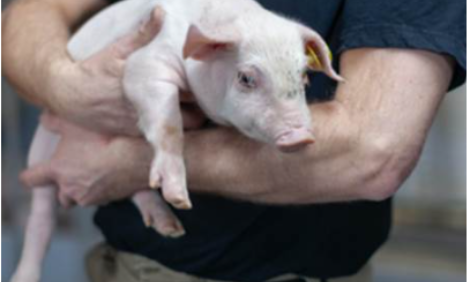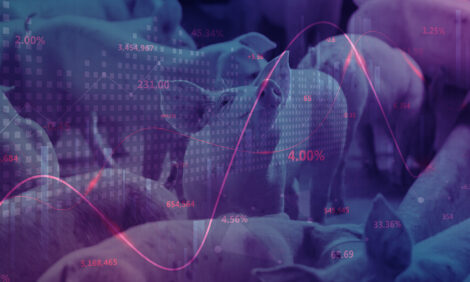



Leman Swine Conf.: Soy bioactive compounds show promise in cutting PRRS-related mortality
Research shows how bioactive compounds in soybean meal can reduce inflammation, support respiratory health and improve survivability in PRRS-challenged pigs
Dr. Ryan Dilger, professor at the Department of Animal Sciences at the University of Illinois, Champaign-Urbana, and Dr. Brooke Smith, veterinary nutrition lead at Cargill Animal Nutrition, recently spoke to The Pig Site’s Sarah Mikesell at the Leman Swine Conference in St. Paul, Minnesota, USA.
Dr. Dilger, can you share the information from your presentation with our readers?
I presented information about bioactive compounds in soy and how they have immunomodulatory effects. Bioactive compounds can regulate how the immune system works in a pig that's experiencing a respiratory disease.
One of our goals is to minimize the frequency, duration and magnitude of the immune response using bioactive compounds in natural ingredients like soy to shape the immune response before, during and after a disease challenge.
What are the specific bioactive compounds we should be aware of, and what's their potential impact on the immune system?
Isoflavones and saponins are naturally occurring and complementary modulators, called secondary metabolites. Both are very minor fractions in soy and are not nearly at the level of protein or other carbohydrates found there. However, they have profound effects when it comes to how inflammation occurs in a pig that is sick with respiratory disease.
Isoflavones are absorbed, circulate and act in the lung and immune cells. They support adaptive immunity while reducing viral load.
Saponins are not absorbed but act locally in the gut, indirectly influencing systemic immunity. Saponins also help to maintain the integrity of the intestines and strengthen the epithelial barrier in the gut, so pigs don't get secondary infections.
Isoflavones and saponins provide anti-inflammatory, anti-viral and anti-oxidative benefits.
From your perspective, where does the field stand today in terms of soy bioactives and what future research directions do you see as important?
Soy bioactives are functional feed components with high potential, and we are now recognizing what these secondary metabolites can do. Because they're already part of soybean meal in the diet, we're starting to better understand how we can pair them with therapeutic agents. In doing so, we can have complementary harmony between nutrition and health. Bioactives represent an opportunity to get out in front and be proactive with nutrition when we know pigs are going to have a respiratory illness.
Regarding future research direction, first we need to understand the isolated effects of each of these compounds. Once we know that, we can potentially start to use them from a breeding and genetics perspective with the soybean plant itself to enrich these products.
From a processing perspective, there’s an opportunity to enrich both the isoflavones and saponins in the final product. By improving the quality of the soy product, not only by providing amino acids as a protein source, but also by improving the availability of isoflavones and saponins as secondary metabolites in the diet, perhaps we can produce healthier, more resilient pigs in the future.
A question for both of you…what about potential research on this topic in sows?
Most of our research today has focused on the young pig, and Brooke’s work goes all the way through to market. So, there's not much known about how these compounds affect sows. There's a lot of interest because if we can help to program the immune system for a young pig, it could have some profound effects down the road. There is a lot of interest there, but not a lot of research just yet.
When doing sow research, we should consider opportunities within feeding to modulate based on when the sow is infected and which gestation phase is she in. This could have a substantial impact on progeny. However, supporting the sow's immune response may or may not mitigate viral behavior between the dam through the placenta to her offspring. Also, we believe isoflavone circulation through milk can be influenced by many factors. Thus, the sow question is complicated because it’s over a period when there are a lot of physical changes happening to the sow.
Dr. Smith, now that we better understand soybean bioactive compounds and their role in mitigating respiratory disease, tell us about your research.
The research that I presented today was a cornerstone study of my thesis research. The focus of that research was trying to isolate more of the isoflavones’ effects on the clinical response to a PRRS challenge in the immediate post-weaning period and how it impacts the pig, performance to harvest.
What were the most notable study results?
The substantial changes to note were in the dynamics of viral clearance, as evidenced by oral fluids and the neutralizing antibody response.
The most profound difference that we saw was on mortality. When we looked at the weaned market period, the group that received the supplemental isoflavones had almost 50% less mortality across that period compared to our positive control.
That's a significant impact on PRRS virus-related mortality. Can you give us an example of how that translates to economics?
We can all appreciate that a pig that makes it to market is worth more than one that doesn't. With the work of one of my colleagues, we were able to take the live market weights from the study and model them on three relevant packer grids on a regional basis.
What we saw was that there was a proportional increase in projected revenue. When you market more pigs, it results in more revenue, even despite differences in categorization of weight-penalty classes.
In that scenario, survivability is king. The pigs that were PRRS-challenged may never be as full value as those that were not, but getting more pigs out the door and to market is better for our producers. In other words, it's pounds out the door as much as it is the animal itself – that's how producers make money.
Dr. Smith, what is the key takeaway for veterinarians and producers when considering nutritional solutions as swine respiratory disease management tools?
When we look at the entire picture, nutrition is a part of it – just like everything else. I think it's one of those solutions that continues to be underutilized or under-emphasized. Part of it is understanding that bioactives are in ingredients that we use commonly. We can leverage them, and we can do so in an informed way based on how we know processing impacts them.
The best-case scenario is to have all the players who will influence the success of your production at the same table having a conversation. The more your veterinarian and nutritionist know about the challenges these pigs are facing, the more responsive and adaptive they can be developing a holistic plan to improve health.
Dr. Dilger, what are the key takeaways from your perspective?
Communication is going to be key. Using nutrition as a proactive insurance tool can be better utilized. It's a low-cost solution that we can use to help modulate immune response.
We can use soy to give young pigs a leg up, if you will, from the very beginning when they're most vulnerable. They don't have their full immune system developed at that point, and we can add soy nutritionally as kind of insurance in the diet.
More information about the importance of soy in pig diets is available at can.ussoy.org. This program has been brought to you by U.S. Soy, and it’s fully funded by the Soy Checkoff.









